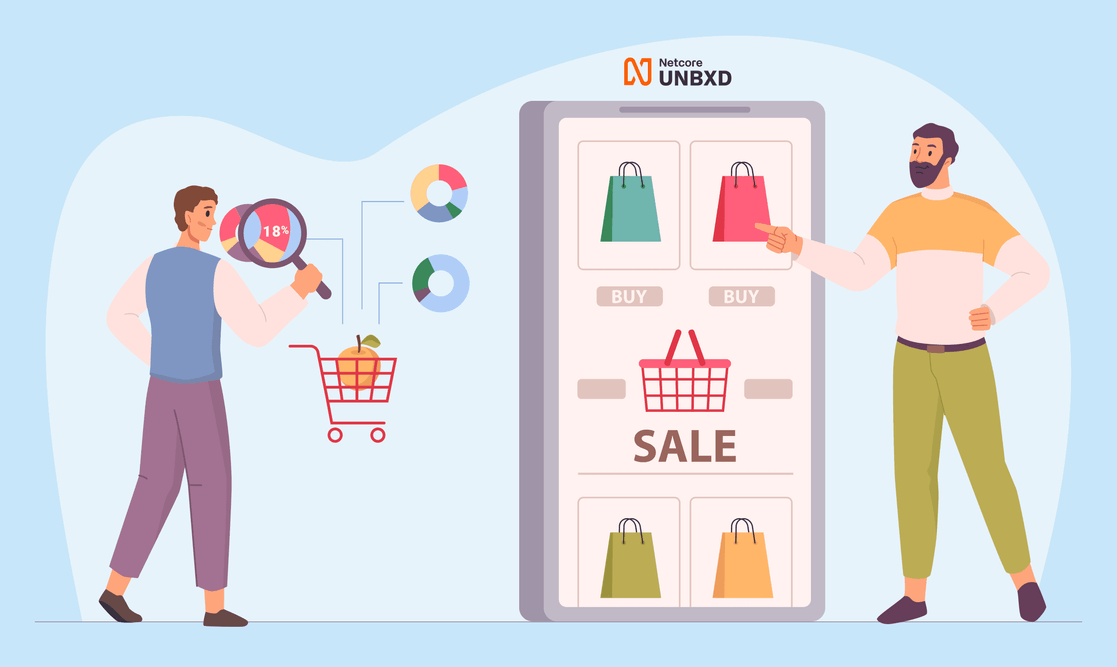- ProductsSearch and BrowseRecommendations
- Solutions
- Integrations


Your shopper wants to find the perfect pair of jeans that compliments their style. They’ve got specific preferences—slim fit, high-rise waist, and a classic blue color. Their hope? To find the ideal pair that complements their style and comfort. However, as they browse the jeans section, they’re bombarded with ads for baggy jeans, low-rise cuts, and a range of colors that don't match their taste. It's like the website doesn’t care and promotes–one style, one fit, and one color, to all.
The then-happy-now-frustrated shopper thinks, "Where are the slim fits? Where are the high-rise options? Why do I see ads for styles I would never wear? Ugh, let me find a different store."
This is the major pitfall of a "one size fits all" strategy. It's like going to a restaurant that puts only one dish on the menu, regardless of what they have in the kitchen. It benefits no one and is a sure-shot way to reduce traffic, revenue, and shopper satisfaction.
So, what's the solution? Many would say "personalization," but there's a challenge.
- Retailers may not always know what each shopper wants, especially new visitors. (Netcore Unbxd does solve this problem with features like cold starts and in-session personalization.)
- And retailers can't create separate strategies for every shopper – it's just not feasible.
That’s where shopper segmentation comes into play.
Shopper segmentation: The legacy format
Segmentation involves dividing shoppers into smaller, more targeted groups based on demographics, geography, and device type. However, traditional segmentation based on broad categories may still miss the mark when it comes to addressing specific shopper needs.
Advancing beyond the default options
Netcore Unbxd's advanced segmentation takes it a step further, allowing retailers to choose business-specific conditions based on which shoppers get segmented. This means retailers can delve deeper into shopper preferences and create segments with attributes like "jeans fit preference" (e.g., slim fit, regular fit, relaxed fit), "waist height preference" (e.g., high-rise, mid-rise, low-rise), and/or "color preference" (e.g., classic blue, black, distressed).
When shoppers feel understood and catered to on a personal level, they are more likely to return to the store for future purchases, boosting shopper loyalty. With a robust segmentation and targeting mechanism in place, you can
- Tailor product recommendations, promotions, and content
- Increase shopper loyalty and repeat purchases through targeted marketing
- Boost conversion rates with relevant offers and recommendations
- Enjoy a competitive advantage by delivering superior experiences
Here are a few use cases on how advanced segmentation can help!
Location:
Scenario: A global cosmetics brand wants to optimize its marketing campaigns for different regions. Solution: By grouping shoppers based on their geographical location, the brand can create region-specific promotions, highlight products popular in each area, and offer localized product content, driving engagement and conversions.
Behavior:
Scenario: An electronics retailer aims to increase sales among tech-savvy shoppers. Solution: By grouping shoppers based on their device preferences, browsing behavior, and past purchases, the retailer can recommend relevant tech accessories, offer exclusive deals on popular gadgets, and create targeted email campaigns tailored to each segment's interests.
New vs. Returning Shopper:
Scenario: A subscription-based service wants to improve customer retention and increase subscription renewals. Solution: By grouping shoppers into new and returning categories, the service can offer personalized incentives such as discounts on the first subscription, loyalty rewards for returning shoppers, and targeted communication based on each segment's engagement history.
Purchase History:
Scenario: A fashion retailer wants to promote new arrivals to shoppers with a history of high-value purchases. Solution: By creating groups based on purchase history, order frequency, average order value, and product categories purchased, the retailer can create VIP segments that receive early access to new collections, exclusive discounts, and personalized styling recommendations.
In essence, advanced segmentation is a powerful ability that empowers ecommerce businesses to deliver personalized, relevant, and engaging experiences. By understanding the diverse needs and preferences of different shopper segments, online retailers can unlock new opportunities for growth, increase shopper satisfaction, and stay ahead in the competitive landscape.
Embracing advanced segmentation is not just a strategy; it's a mindset shift towards consumer-centricity and excellence in online retailing. Get a demo today!